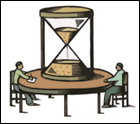In 1999, when researchers at MIT teamed with the Uniform Code Council, Gillette and Procter & Gamble to pursue the dream of RFID everywhere, many critics dismissed us as lunatics. They summed up our vision and work with one contemptuous word: “unrealistic.”
Turns out these naysayers weren’t realists at all; they were pessimists. Optimist or pessimist, you must now set aside your prejudices and face reality. Barring a meteor strike, RFID will be ubiquitous by the end of the decade. Wal-Mart and the U.S. Department of Defense are committed to using it, and other retailers and government agencies will follow. RFID will become better and cheaper as more companies adopt it, creating a virtuous cycle. It makes for a pretty steep adoption curve. The only thing steeper will be the learning curve. Letting a competitor get ahead of you could be fatal for your business. Here are five facts you need to face right now.
The world’s RFID platform will be called EPC, and it will be administered by EPCglobal. Non-EPC–based RFID will eventually go the way of non-IBM PCs: extinction, legacy or niche.
Version 1 of the EPC Network is not the exact form of RFID that will be everywhere. The technology and EPCglobal are still stabilizing. Specifications will be dynamic for a few more years. This will have a negative—but temporary—effect on price, performance and interoperability.
Self-proclaimed “realists” (they’re actually pessimists, remember) will tell you to do nothing until all of these issues are sorted out. But leaders such as Wal-Mart, Tesco, P&G and Gillette aren’t sitting around waiting. If you want to win in your market—whether you’re an RFID user or a vendor—you shouldn’t either. You need to start experimenting with EPC today. With forward compatibility pretty much guaranteed, the risk is low. Wait for the dust to settle and it will probably settle on you.
There’ll be bad news. EPC technology is immature. There will be bugs, and a few implementations will end in spectacular failures. Some CEOs will vent their frustrations in public. Self-important journalists, sulky analysts (especially those among the naysayers) and other species of Monday morning quarterbacks will exaggerate any bumps. You’ll have to filter this information and make some realistic assessments about what’s happening.
This is a once in a lifetime opportunity. Take it. Being afraid to make mistakes is the biggest mistake of all.
Realism doesn’t mean expect the worst or refrain from planning until you know what will happen with 100 percent certainty. It means you face reality, whether or not you like it, and deal with the changing business environment as best you can. And the reality is that RFID everywhere is coming. Really.
Kevin Ashton was cofounder and executive director of the Auto-ID Center. He’s now writing a book about RFID and rediscovering weekends.



